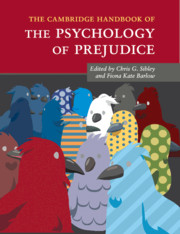Book contents
- Frontmatter
- Dedication
- Contents
- List of Figures
- List of Tables
- Notes on the Contributors
- Part I General Theoretical Perspectives
- Part II Prejudice in Specific Domains
- 11 Understanding the Nature, Measurement, and Utility of Implicit Intergroup Biases
- 12 Aversive Racism and Contemporary Bias
- 13 Ambivalent Sexism in the Twenty-First Century
- 14 Sexism in Intimate Contexts: How Romantic Relationships Help Explain the Origins, Functions, and Consequences of Sexist Attitudes
- 15 Religion and Prejudice
- 16 Sexual Prejudice: Advances in Conceptual and Empirical Models
- 17 Weight Bias: Prejudice and Discrimination toward Overweight and Obese People
- 18 Prejudice Against Immigrants in Multicultural Societies
- 19 Generalized Prejudice: Old Wisdom and New Perspectives
- Part III Prejudice Reduction and Analysis in Applied Contexts
- Index
- References
19 - Generalized Prejudice: Old Wisdom and New Perspectives
from Part II - Prejudice in Specific Domains
Published online by Cambridge University Press: 17 November 2016
- Frontmatter
- Dedication
- Contents
- List of Figures
- List of Tables
- Notes on the Contributors
- Part I General Theoretical Perspectives
- Part II Prejudice in Specific Domains
- 11 Understanding the Nature, Measurement, and Utility of Implicit Intergroup Biases
- 12 Aversive Racism and Contemporary Bias
- 13 Ambivalent Sexism in the Twenty-First Century
- 14 Sexism in Intimate Contexts: How Romantic Relationships Help Explain the Origins, Functions, and Consequences of Sexist Attitudes
- 15 Religion and Prejudice
- 16 Sexual Prejudice: Advances in Conceptual and Empirical Models
- 17 Weight Bias: Prejudice and Discrimination toward Overweight and Obese People
- 18 Prejudice Against Immigrants in Multicultural Societies
- 19 Generalized Prejudice: Old Wisdom and New Perspectives
- Part III Prejudice Reduction and Analysis in Applied Contexts
- Index
- References
Summary
Some individuals seem to carry prejudice with them, from context to context, from attitudes toward one group to attitudes toward other, seemingly unrelated, groups. This reveals itself in correlations between different kinds of prejudice, for example, against Jews and old people. This observation also represents one of the oldest lessons in the prejudice literature (Allport, 1954; Hartley, 1946). What is perhaps more startling is just how much of the variance is shared between different prejudices. More than half of the individual variability in devaluing attitudes toward immigrants; women; gays; and old, overweight, or disabled people can be traced to the same underlying factor (generalized prejudice; see Bergh, Akrami, & Ekehammar, 2012; Ekehammar & Akrami, 2003). Such a big chunk of variance would seem difficult to overlook in the pursuit of a comprehensive understanding of prejudice.
In this chapter we initially cover some basic empirical findings and discuss how descriptions of generalized prejudice factor(s) have developed over time. What they all have in common is the idea that devaluing and/or negative attitudes are generalized across group domains (e.g., against various ethnic, age, and religious groups). However, as we elaborate, there are also important themes that differentiate certain views. Second, we discuss some proposed contradictions to generalized prejudice research, as connected to a declining popularity of the concept since Allport's time. We note how many of these seeming contradictions can be resolved by statistical reappraisals. In the final section, we discuss a new perspective on what generalized prejudice represents. A central question here is whether generalized prejudice is associated more with a comprehensive concern for societal “order” rather than reflecting an “us versus them” mentality.
The Empirical “Fact”
Generalized prejudice is primarily reflected in the correlation between measures of devaluation of different groups. Hartley (1946) was one of the pioneers in examining this issue. His participants provided social distance ratings for 39 social groups (mainly ethnic ones), but also three fictitious groups (e.g., Pireneans). He found many substantial correlations between the various group evaluations, including the fictitious ones. Some eight years on, and many studies later, Allport (1954) proclaimed that the generalization of prejudice was “one of the facts of which we are most certain” (p. 68). As provocative as that may sound, and as much as scholars have since departed from his views, there is strong evidence for the basic idea that prejudice reproduces across targets.
- Type
- Chapter
- Information
- The Cambridge Handbook of the Psychology of Prejudice , pp. 438 - 460Publisher: Cambridge University PressPrint publication year: 2016
References
- 11
- Cited by



